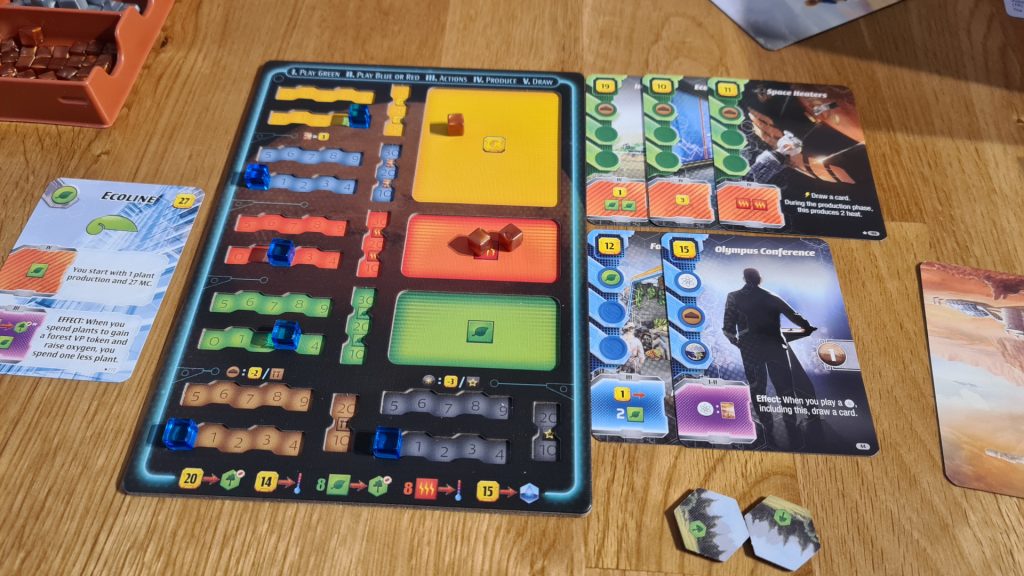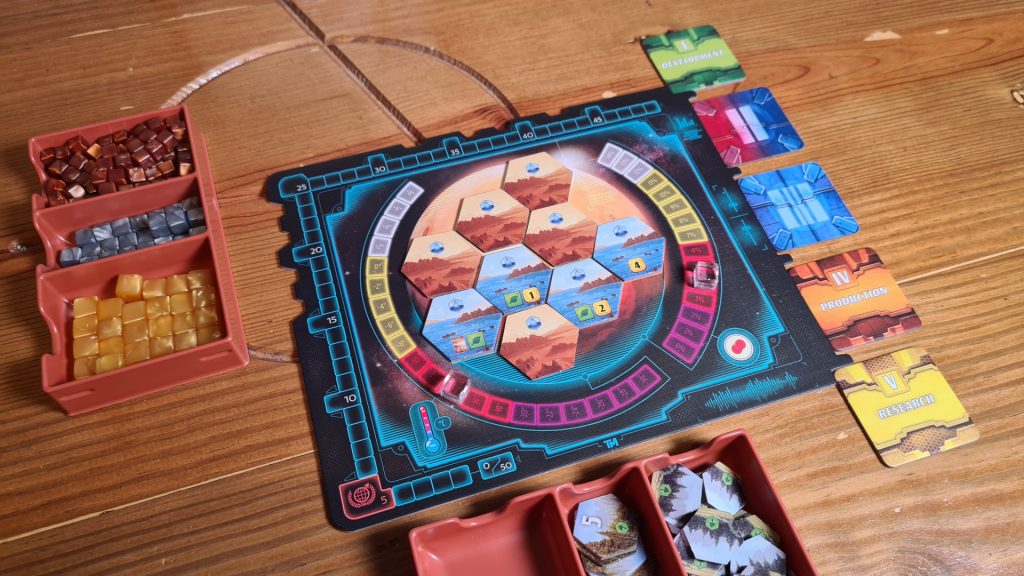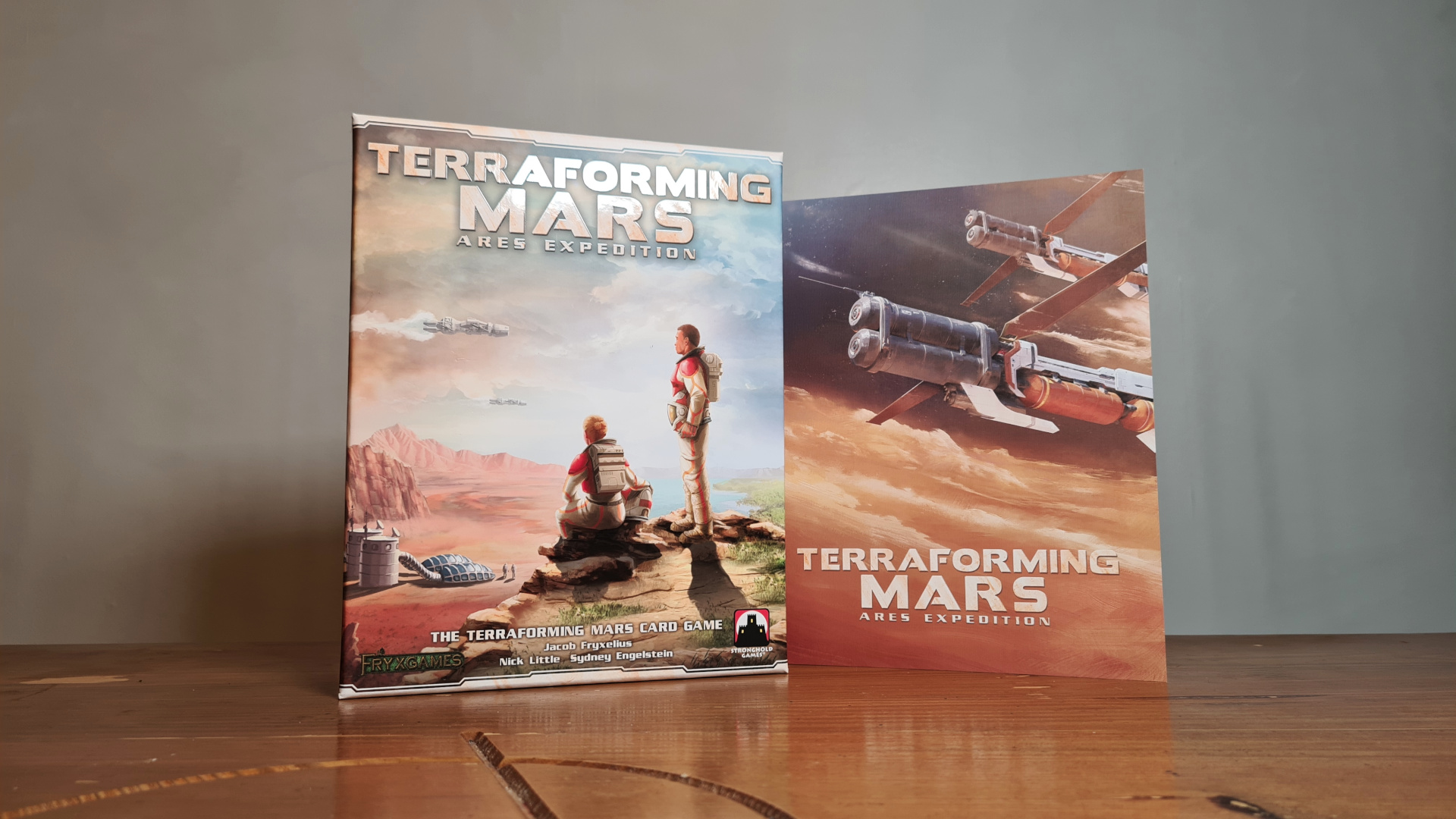Terraforming Mars Ares Expedition is the brand new engine building card game from publishers FryxGames and Stronghold Games. Designed by Sydney Engelstein, Jacob Fryxelius and Nick Little, the game sees 1 – 4 players once again go to Mars, with the objective of terraforming the planet. Described solely as a card game, gamers may be confused how the original TM title wasn’t a card game also. With streamlined elements, oceans, temperature and oxygen are still the objectives. So, is this just more of the same? Let’s find out!
To set up the huge deck of project cards is shuffled, with 8 cards dealt out to each player. Each player also receives 2 corporation cards. These give each player unique starting resources, as well as an ability to use during play. For example, the Ecoline corp starts with only 27 megacredits (MC) but 1 plant production and forest tokens are cheaper for them. Another, the Credicor corp, starts with 48 MC and gains a discount on projects costing more than 20 MC.
At this stage players can freely discard any number of project cards to redraw the same number, with no costs for keeping cards. A small central board is filled with facedown ocean tiles added and tokens are placed onto the bottom of the three terraforming parameter tracks. With each player choosing a colour, they take the cubes of that colour – placing one on the 5th space of the terraforming tracker. Lastly, they take a player board and a set of 5 phase cards.
At the start of a round all players simultaneously look at their phase cards and choose one – keeping it face down. Choosing a phase guarantees it’ll be performing in that round and also gives the player a small bonus/cost reduction. Once all players have chosen, the cards are revealed and which phases the round will include is determined. Players can choose to use the included phase tokens to indicate what is included by flipping them to the active/inactive sides. Importantly, a phase will not occur if it was not selected by a player.
The activated phases are always played in a specific order. All players can perform the activated phase simultaneously regardless of whether it was chosen by themselves or others. First is the development phase, which lets players play a green project card from their hand, paying its cost and minding any requirements. Those that chose the phase can do this with a 3 megacredit discount. Next, is the construction phase, where players can play a blue or red production card. Those that choose the phase can then either play a second blue/red card or draw a card from the deck.

The action phase is then triggered if active in the round. This enables the player to activate each of their blue action cards once, and perform standard actions as many times as they can afford. Those that selected Action can then perform one of their blue card actions a second time. Production is the fourth phase, with each player then collecting resources based upon their constructed green project cards, corporation card and for megacredits also their position on the terraforming rating tracker. Those that selected production get a bonus 4 megacredits for choosing the phase. The final possible phase is the research phase, which sees all players draw two cards and keep one. Those that chose the phase instead draw five cards and keep two.
Whenever a player raises the temperature, increases the oxygen (via a card effect or building greenery) or flips an ocean they gain a terraforming rating, and points are the aim of the game. As the phases are performed simultaneously there are single rounds when the terraforming parameters reach their limit. For these rounds only a player can effectively push the parameter higher than the top, still gaining the Terraforming Rating increase. In rounds after a parameter hits the limit then this cannot be done, though greenery can still be built.
At the end of each phase players check to see if the parameters have all reached their limits: all 9 ocean tiles flipped, temperature at +8 degrees and 14% oxygen. If this is the case the game ends at the end of the current phase, not the current round. Checking takes seconds, so it doesn’t become disruptive. Plus, players will want to stay up-to-date on the parameters anyway; not only to see when the end of the game will occur but some cards cannot be played until certain parameters have been reached.
If the limits haven’t been reached at the end of a round then another round occurs, with no fixed amount of rounds. Importantly, players cannot pick the same phase two rounds in a row, which only makes the decision of when to pick something harder. When the game ends players calculate their points, based on their terraforming rating, forest tokens for greenery and any points on constructed cards. Whomever has the highest points wins, with ties split but combined heat, plant and megacredit resources.
The aim might be the same as the original game and even what cards may offer production wise is similar. However, the core is very different. Gone is the board control element, so that’s a huge chunk not needing to be closely followed by players. The managing of resources is still there for paying for cards and working towards the terraforming actions, though this is somewhat streamlined so there is again less to keep track of. The way that not everything can be done in a round and the process behind determining what phases are in a round is what changes things.
The logics learnt of generations in the original to Terraforming Mars Ares Expedition is interesting to get past. What might be an incredible action in Terraforming Mars – where it could be used once a generation – suddenly isn’t as good in this game where that specific phase of the round might not occur. This choice of phases can be as important as what cards someone has played, as it’s pointless having blue action cards played if there’s never the Action phase to activate them.

As more players play Terraforming Mars Ares Expedition the more phases occur each round, so rounds go on longer but feel more fulfilling. It’s not a certainty though, and there’s always a bit of a laugh when everyone takes a while choosing which phase to select, only for everyone around the table to have picked the same one. At 2 players the rounds can be zoomed through with only a couple of phases activated. The game doesn’t seem to massively speed up or down with more phases as the amount of terraforming doesn’t change – and with income not based on rounds it isn’t like a 2 player game sees resources be any more plentiful.
Analysis Paralysis prone players, where it takes you a long time to make any choice, beware. There are countless choices to make every single round. Not just which cards you want to play but what phases you want to occur, combined with determining what phase an opponent might play. There are a lot of avenues of possibility resulting from the choices made and if you sit and calculate them all then the game can go on for as long as a normal Terraforming Mars game, despite this having the streamlined potential to be an hour long experience.
One issue many had with the original was the visual presentation and production. The fact that the likes of Etsy are full of dual layered player boards was a testament of that. Terraforming Mars Ares Expedition steps up the game, coming with those dual layer player boards from the offing. With over 200 cards included in the game the interface of the cards has been updated, which allows a consistent look across the deck. On top of this the full deck uses one art style, giving the game a stunning look.
Included in the box is a very black and write, almost prototype, looking extra rulebook. This quickstart guide hasn’t received the luxury rulebook treatment but is phenomenal for those whom have played Terraforming Mars before. Bullet pointed are all the tweaks and changes, as well as the similarities, to the original game, with quick setup reminders and a brief outline of the phases and rules. This isn’t just useful for those that played the original though, it can be used by those returning to Ares Expedition to skim the rules and get playing quicker.
The big question for many is if they didn’t like the original, or loved it, would they enjoy Terraforming Mars Ares Expedition. There has been a big change in the flow of the experience, with players actively choosing the phases of each round that will be performed. This is a distinct change from the original that allows the game to feel like it’s own experience – whilst still drawing on a lot of Terraforming Mars for the rest.
It’s perhaps the streamlining that many will find more exciting, as the original was never a short game. With less to track and faster, simultaneous, turns this could convince many who were put off by the length of the original. Despite the changes, it isn’t too distant. With the logics of playing cards, restrictions, costs and benefits being similar, fans of the series will pick the experience up quickly, and unless their favourite part was the slowly controlled and terraformed board in the middle, they should at the very least enjoy Terraforming Mars Ares Expedition.
(Editor’s Note: Terraforming Mars Ares Expedition was provided to us by Asmodee for the review. The game is currently available from local board game stores! Find your local store here.)

